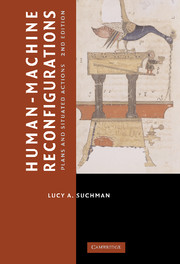Book contents
- Frontmatter
- Contents
- Acknowledgments
- Preface to the 2nd Edition
- Introduction
- 1 Readings and Responses
- 2 Preface to the 1st Edition
- 3 Introduction to the 1st Edition
- 4 Interactive Artifacts
- 5 Plans
- 6 Situated Actions
- 7 Communicative Resources
- 8 Case and Methods
- 9 Human–Machine Communication
- 10 Conclusion to the 1st Edition
- 11 Plans, Scripts, and Other Ordering Devices
- 12 Agencies at the Interface
- 13 Figuring the Human in AI and Robotics
- 14 Demystifications and Reenchantments of the Humanlike Machine
- 15 Reconfigurations
- References
- Index
- Frontmatter
- Contents
- Acknowledgments
- Preface to the 2nd Edition
- Introduction
- 1 Readings and Responses
- 2 Preface to the 1st Edition
- 3 Introduction to the 1st Edition
- 4 Interactive Artifacts
- 5 Plans
- 6 Situated Actions
- 7 Communicative Resources
- 8 Case and Methods
- 9 Human–Machine Communication
- 10 Conclusion to the 1st Edition
- 11 Plans, Scripts, and Other Ordering Devices
- 12 Agencies at the Interface
- 13 Figuring the Human in AI and Robotics
- 14 Demystifications and Reenchantments of the Humanlike Machine
- 15 Reconfigurations
- References
- Index
Summary
Agency is not an attribute but the ongoing reconfigurings of the world.
(Barad 2003: 818)In this chapter I consider some new resources for thinking about, and acting within, the interface of persons and things. It is here, on the question of alternatives to information theoretic approaches to human–machine interactions, that I believe the ground has shifted most radically over the past twenty years. The shifts involve reconceptualizations of the social and the material and the boundary between them, with associated implications for practices of system design. The explorations are ongoing within relevant areas of cultural anthropology. science and technology studies. feminist theory, new media studies, and experiments in cooperative systems design, each of which is multiple and extensive in themselves and no one of which I can do full justice to here. I hope nonetheless to trace out enough of the lines of resonance that run through these fields of research and scholarship to indicate the fertility of the ground, specifically with respect to rethinking and creatively enacting the interface of humans and machines.
EXCLUDED MIDDLES
It was the circular move of writing a cognitivist rationality onto machines and then claiming their status as models for the human that first provoked me to question the notion of intelligent, interactive artifacts. My concern then, as now, has to do with the implications of this move both for our notion of what machines are and also with ways in which the premises and products of artificial intelligence research continue to restage traditional Euro-American assumptions about the nature of being human.
- Type
- Chapter
- Information
- Human-Machine ReconfigurationsPlans and Situated Actions, pp. 259 - 286Publisher: Cambridge University PressPrint publication year: 2006
- 1
- Cited by

